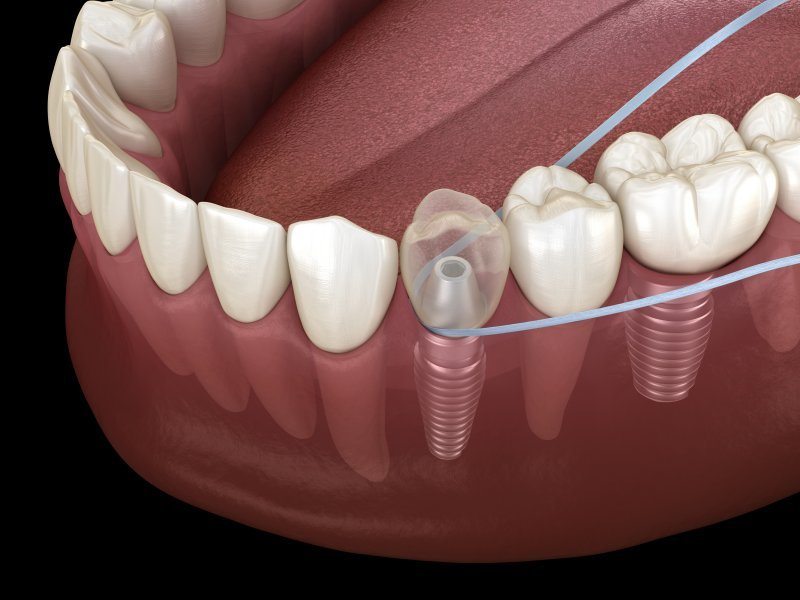
Maintaining dental implants is crucial for their longevity, and an essential part of care is flossing. While it may seem challenging, flossing dental implants is easier than it sounds. Regular flossing is vital for removing plaque and debris from around the implants. By using implant-friendly floss, you can effectively clean the crevices. Proper implant care is necessary for preserving your oral health and the longevity of your dental implants. So, understanding how to floss them is essential. Flossing these dental superheroes ensures they continue to save the day by replacing missing teeth and restoring your smile, maintaining their tip-top shape for years to come.
How to Floss Dental Implants?
- Start by choosing an interdental brush or floss specifically designed for dental implants.
- Gently insert the brush or floss between the teeth and implants.
- Move the brush or floss back and forth to clean the sides of the implants and the surrounding gumline.
- Be careful not to apply too much pressure to avoid damaging the implants or causing gum irritation.
- Rinse your mouth with water or mouthwash to remove any remaining debris.
Remember to floss at least once a day to maintain optimal oral hygiene and keep your dental implants clean and healthy.

How to Floss Dental Implants?
Flossing dental implants is an essential part of maintaining good oral hygiene and ensuring the longevity of your implants. While flossing may seem straightforward, there are specific techniques and considerations that are unique to dental implants. In this article, we will explore the proper steps to flossing dental implants and provide helpful tips to ensure optimal oral health.
The Importance of Flossing Dental Implants
Flossing dental implants is crucial because it helps remove plaque and debris from hard-to-reach areas between the implants and your natural teeth. Without proper flossing, bacteria can accumulate and cause inflammation, infection, and even implant failure. It is essential to establish a regular flossing routine to maintain the health of your implants and surrounding gums.
When flossing dental implants, it is important to use the right tools and techniques to avoid damaging the implant or causing discomfort. Here are the steps to follow for effective flossing:
Step 1: Choose the Right Floss
When selecting floss for dental implants, opt for a soft, waxed floss or a floss specifically designed for implants. These types of floss are gentle on the gums and less likely to shred or get stuck between the implant and the natural tooth.
Step 2: Use Proper Technique
Start by cutting a piece of floss about 18 inches long. Wrap the ends of the floss around your index fingers, leaving a few inches in between. Gently guide the floss between the implant and the neighboring tooth, using a back-and-forth motion. Be careful not to snap the floss or apply excessive force, as this can damage the implant or irritate the gums.
Step 3: Clean Each Side of the Implant
Once the floss is between the implant and the adjacent tooth, curve it into a C-shape around the implant. Gently slide the floss up and down, making sure to clean both sides of the implant. Repeat this motion for each implant and tooth in your mouth.
Step 4: Rinse and Repeat
After flossing between each implant, rinse your mouth thoroughly with water or an antimicrobial mouthwash to remove any residual debris. Then, repeat the flossing process on the opposite side of your mouth, ensuring all areas are adequately cleaned.
Tips for Effective Flossing
To enhance your flossing routine and maximize the benefits for your dental implants, consider the following tips:
1. Use an Implant-Specific Floss
Implant-specific floss is designed to glide smoothly between implants without causing damage. It is gentler on the gums and less likely to fray or shred.
2. Be Gentle
Avoid applying excessive force or snapping the floss, as this can cause discomfort or damage to the implant. Use a gentle back-and-forth motion to clean between the implant and neighboring tooth.
3. Consider Flossing Alternatives
If traditional flossing is challenging or uncomfortable, consider alternative flossing methods such as water flossers or interdental brushes. These tools can effectively clean between dental implants and provide an alternative for those with dexterity issues.
4. Maintain Regular Dental Visits
Regular dental check-ups are essential for monitoring the health of your dental implants and ensuring proper oral hygiene. Your dentist or dental hygienist can provide professional cleaning and guidance on maintaining optimal implant care.
In conclusion, flossing dental implants is a critical aspect of maintaining their health and longevity. By following the proper techniques and using the right tools, you can effectively remove plaque and debris, reducing the risk of infection and implant failure. Remember to be gentle, use implant-specific floss, and consider alternative flossing methods if necessary. With regular flossing and dental visits, you can keep your dental implants in optimal condition for years to come.
Key Takeaways: How to Floss Dental Implants?
- Flossing dental implants is important for maintaining oral hygiene.
- Use a soft nylon floss to gently clean around the implant.
- Slide the floss gently between the implant and the adjacent tooth.
- Move the floss up and down to remove any plaque or debris.
- Be careful not to apply too much pressure to avoid damaging the implant or surrounding gums.
Frequently Asked Questions
Q: Can I floss dental implants like natural teeth?
Yes, you can floss dental implants just like natural teeth. However, it is important to take some precautions to ensure you do not damage the implants or the surrounding gums. Here’s how you can floss dental implants effectively:
1. Choose the right floss: Opt for a soft, waxed floss or a floss specifically designed for dental implants. These types of floss are gentle on the implants and less likely to cause irritation.
2. Be gentle: When flossing around dental implants, use a gentle back-and-forth motion rather than forcefully pushing the floss between the teeth. This will help prevent any unnecessary pressure on the implants.
3. Use a floss threader: If there is a bridge or bar connecting multiple dental implants, a floss threader can be helpful. Thread the floss through the loop of the threader and gently guide it under the bridge or bar to clean the area thoroughly.
Q: How often should I floss dental implants?
Flossing dental implants daily is crucial for removing plaque and food particles that can lead to gum issues. It’s recommended to floss gently and thoroughly around all sides of the implants. Consult your dentist for personalized advice based on your implant placement and oral health.
Q: Are there any special flossing techniques for dental implants?
While flossing dental implants is similar to flossing natural teeth, there are a few techniques that can help ensure effective cleaning without causing any harm:
1. Slide the floss gently: When flossing between dental implants, slide the floss gently up and down, following the contour of the implants. Avoid snapping or popping the floss, as this may cause damage or discomfort.
2. Curve the floss around each implant: As you floss, curve the floss around each dental implant, making sure to clean both sides. This helps remove plaque and debris from all surfaces, promoting optimal oral hygiene.
By using these techniques, you can maintain the cleanliness of your dental implants and keep your gums healthy.
Q: Can I use a water flosser with dental implants?
Water flossers, or oral irrigators, can be used with dental implants, enhancing oral hygiene by reaching difficult-to-access areas. Begin with low pressure, gradually increasing for comfort and effectiveness. Aim the water stream around each implant, following the manufacturer’s instructions. However, traditional flossing should not be entirely replaced; using both methods ensures thorough cleaning and the well-being of dental implants.
Q: What should I do if I experience bleeding or discomfort while flossing dental implants?
If flossing dental implants leads to bleeding or discomfort, consult your dentist to address potential issues like gum inflammation or infection. Dentists can assess your implants and provide suitable treatments or advice, such as adjusting your flossing technique or using an antimicrobial mouthwash. Early detection and regular dental check-ups are essential to maintain dental implant health, promoting timely issue resolution.
Correct way to floss a dental implant by Periodontal Associates
Final Summary: How to Floss Dental Implants?
In our journey on how to floss dental implants, we’ve emphasized the significance of this practice and provided a comprehensive step-by-step guide. Flossing around dental implants is crucial for maintaining their health and your overall oral well-being. Use a specialized floss for implants, employ gentle yet effective techniques, and be thorough in reaching all areas around your implants. Finish with an antimicrobial mouthwash to keep bacteria in check. By incorporating these flossing techniques into your daily routine, you ensure the long-term success of your dental implants and maintain excellent oral health. Consistency is key, so make flossing a habit for a radiant smile and continued implant vitality. Your diligent care will be rewarding.
Call or Book appointment online
:Ace Dental Care Alpharetta office: 678-562-1555 - Book Now
Ace Dental Care Norcross office: 770-806-1255 - Book Now
Disclaimer
This blog post was generated by artificial intelligence. The content of this post may not be accurate or complete, and should not be relied upon as a substitute for professional advice. If you have any questions about the content of this post, please contact us.
We are constantly working to improve the accuracy and quality of our AI-generated content. However, there may still be errors or inaccuracies. We apologize for any inconvenience this may cause.





